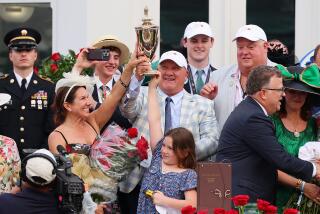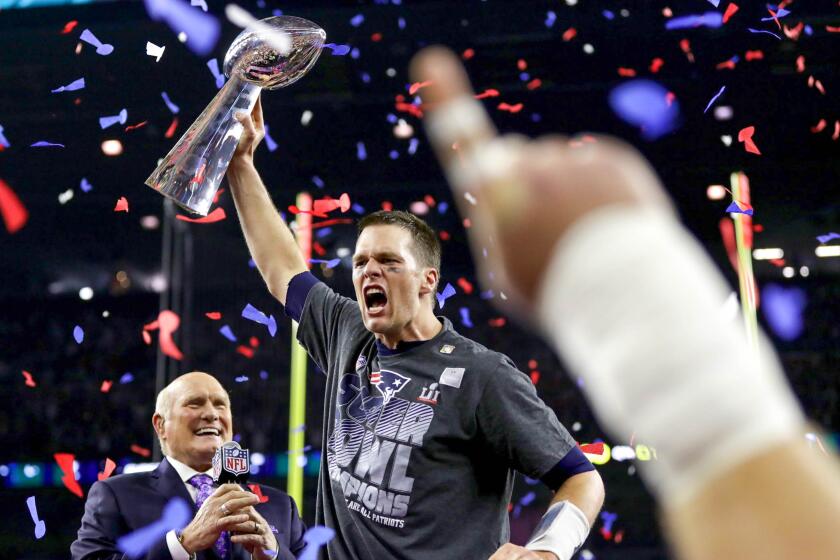COMMENTARY : Simulcasts Need Some Fine Tuning
- Share via
A day at the races in Maryland may leave even the most hard-core horseplayer reeling from sensory overload.
As Laurel offers an expansive menu of full-card simulcasts in addition to its live races, seven tracks may be operating simultaneously -- each with its television signal on different monitors throughout the plant. Fans are bombarded with information, yet most of them complain that tracks do a lousy job giving them the information they want and need.
Bettors in Maryland may never know if a horse at Philadelphia Park hurts himself at the starting gate and is scratched at the last minute. They may be unaware if a sudden storm changes track conditions at Monmouth Park. They may get frustrated waiting for Churchill Downs’ television signal to show probable exacta payoffs.
Many of these problems stem from the fact that fans don’t hear the audio portion of out-of-state signals. Like most simulcast facilities, Laurel turns up the sound from another track’s signal only when a race is being run.
Yet virtually every track in America feels obliged to put an in-house analyst on camera before every race to discuss the horses and make a set of picks.
Simulcast viewers are left to watch somebody’s lips moving on a silent screen. Most of the in-house analysts never have anything useful to say. Instead of having a tanking head declare, “In this race, I like the 2, 8 and 3,” tracks need to find ways to present information graphically.
In Maryland, said simulcast director Dennis Smoter, “we’re going to try to make our graphics a little snazzier.” Many other tracks are doing the same; snazziness is everybody’s obsession. The reason, said Cary Charlson, who runs an Ohio-based company that develops on-screen graphics, is the competition among tracks for simulcast betting dollars. “Simulcasts are no different from products that are competing on the shelves at Kroger’s. Everybody wants to have the best packaging.”
Some of the packaging has been very nifty. Every racetrack routinely displays the numbers of the leading horses while a race is in progress. But Churchill Downs -- using software developed by Charlson -- shows the numbers in the color of each horse’s saddlecloth, with the horse’s odds above it. If the horse who has dashed to the early lead is a 99-to-1 shot, a viewer will know it at a glance.
’ Nor every useful development like this one, however, tracks have begun to clutter their screens with innovations that are gimmicky and useless. Many now display a grid that shows the morning line and then the fluctuations of each horse’s odds every few minutes. Who cares? The morning line at most tracks is wildly inaccurate; the early odds, based on a pittance in the win pool, have little significance. Yet this gimmick usurps the television screen when bettors may be eager to see probable exacta payoffs. Similar wastes of time and space abound.
“Graphics have come a long way,” observed Randy Moss, director of operations at Oaklawn Park. “But it seems that some tracks are so enamored of their bells and whistles that they’ve overlooked the nuts and bolts.”
For the people trying to follow seven tracks at one time, these are the important nuts and bolts:
-- Current odds should be displayed on the screen at all times.
-- Probable payoff for exactas and daily doubles should be diplayed most of the time -- except, perhaps, during the post parade. The most efficient way of showing these payoffs is with a grid that fills the screen with all the combinations at once -- instead of the common, time-consuming method of showing the payoffs with No. 1, then with No. 2, etc.
-- Each horse should be shown in the post parade -- ideally as he starts to gallop.
-- Important changes must be indicated clearly. A simulcast customer should never have to wonder if part of a stable entry is scratched, or if a race has been taken off the grass. Last-minute changes should be emblazoned on the screen. If a horse has been scratched at the starting gate, the television monitor ought to show big, bold flashing letters that declare “NO. 2 HAS BEEN SCRATCHED!” Too often tracks forget that their simulcast customers can’t hear the public-address system announcing this information.
The racing industry will surely go through a lot of trial and error as it tries to create an ideal format for its television product. But it should remember that the people betting seven tracks a day are mostly sophisticated, hard-core fans who don’t care to see talking heads, and don’t care much about the aesthetics of the screen graphics. They want information, not frills.
More to Read
Go beyond the scoreboard
Get the latest on L.A.'s teams in the daily Sports Report newsletter.
You may occasionally receive promotional content from the Los Angeles Times.










